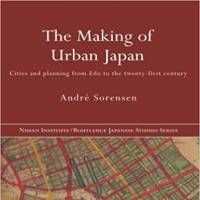In "The Making of Urban Japan," professor Andre Sorensen explains the genesis of modern Japanese cities, from bustling stations to intimate alleyways. Published in 2002, while he was a lecturer at the University of Tokyo, it remains the best introduction to Japanese urban planning in English.
The Making of Urban Japan, by Andre Sorensen.
404 pages
ROUTLEDGE, Nonfiction.
Widespread urbanization began in the Edo Period (1603-1868) when castle towns became merchant centers. By the end of the 18th century, "Japan was one of the most highly urbanized countries," and Tokyo was "probably the largest city in the world," he writes.
After World War II, the pace of industrialization peaked. The responsibilities of national-level government planners increased dramatically with the creation of expressways and the shinkansen. Sorensen argues that the Tokaido Megalopolis, the "vast linear conurbation" connecting Tokyo and Osaka, motivated "virtually all subsequent planning efforts."
In spite of globalization, Sorensen claims that "any superficial similarities" between Japanese and foreign cities "serve merely to disguise profound structural differences." Topography, history and locally-led initiatives like machizukuri (community-building programs) continue to shape Japanese urban space.
Japanese cities are now considered among world's most livable, but Sorensen suggests that aging demographics, rural depopulation, and environmental challenges will keep the nation's planners occupied for decades to come.
Read archived reviews of Japanese classics at jtimes.jp/essential.


















With your current subscription plan you can comment on stories. However, before writing your first comment, please create a display name in the Profile section of your subscriber account page.